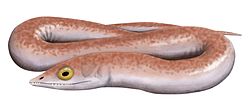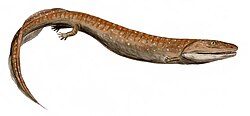| Livoniana Temporal range: Devonian | |
|---|---|
| Scientific classification | |
| Kingdom: | Animalia |
| Phylum: | Chordata |
| Clade: | Eotetrapodiformes |
| Clade: | Elpistostegalia |
| Genus: | † Livoniana |
| Species: | †L. multidentata |
| Binomial name | |
| †Livoniana multidentata Ahlberg et al., 2000 | |
Livoniana is a genus of prehistoric tetrapodomorphs which lived during the Devonian period (Givetian - Frasnian stages, about 374 - 391 million years ago). [1]
This species is a transitional form between fish and the earliest tetrapods, like Tiktaalik , Ichthyostega and Acanthostega . Before Livoniana there was Elginerpeton and Obruchevichthys .
Four legs developed in water, not on land, to better escape waterliving predatory creatures like Hyneria . There were very lush forests, and particularly swamps, where four limbs became very useful to avoid predators. [2]





